Blank L., Tarquin A. Engineering Economy (McGraw-Hill Series in Industrial Engineering and Management)
Подождите немного. Документ загружается.

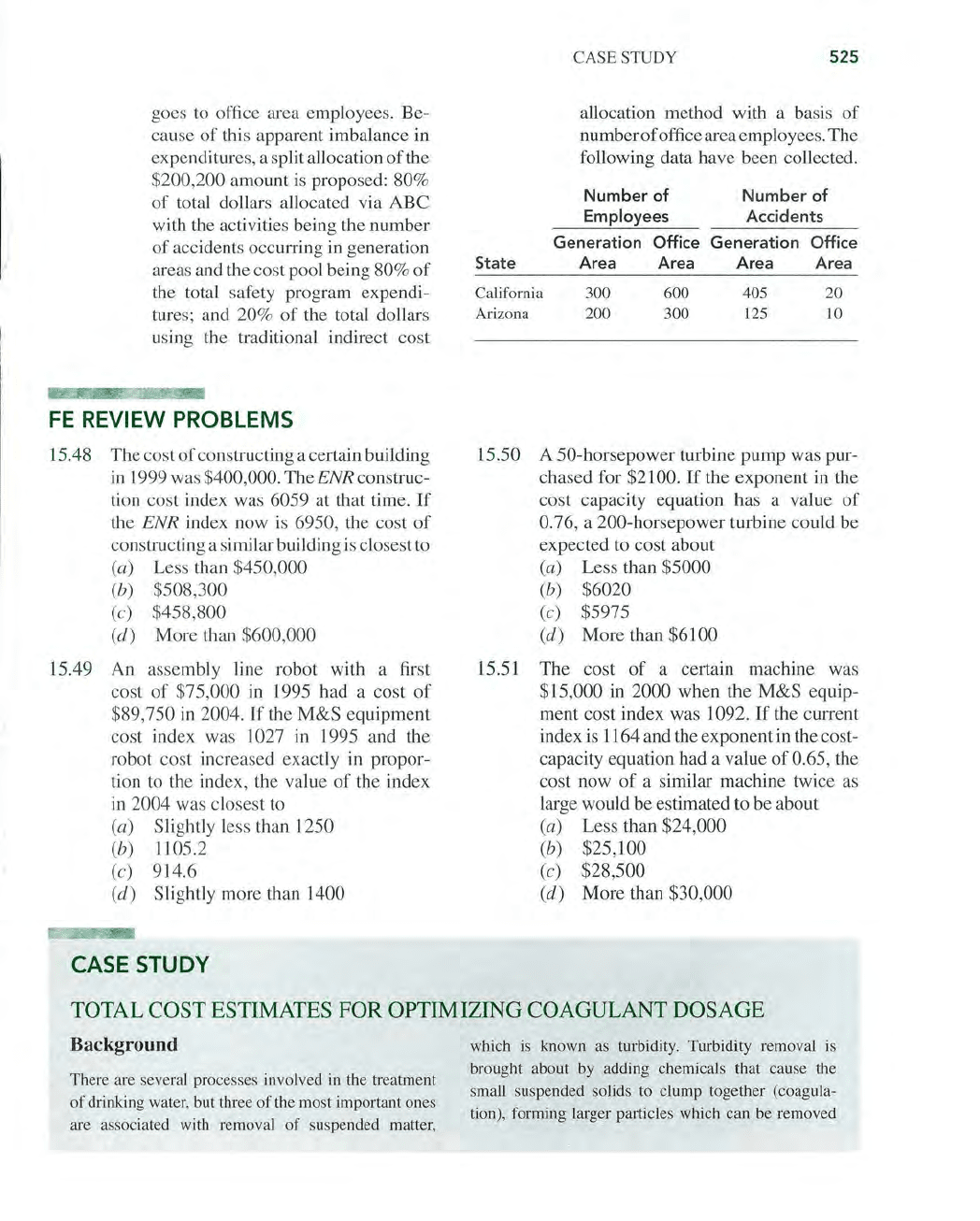
goes
to
office area employees. Be-
cause
of
this apparent imbalance in
expenditures, a split allocation
of
the
$200,200 amount is proposed: 80%
of
total dollars allocated via ABC
with the activities being the number
of accide
nts
occurring
in
generation
areas and the cost pool being
80%
of
the total safety program expendi-
tures; and
20%
of
the total dollars
using the traditional indirect cost
FE
REVIEW PROBLEMS
15.48 The cost
of
constructing a certain building
in 1999 was
$400,000. The ENR construc-
tion cost index was
6059 at that time.
If
the
ENR
index now is 6950, the cost
of
constructing a similar building is closest
to
(a) Less than $450,000
(b) $508,300
(c) $458,800
(d) More than $600,000
15.49
An
assembly line robot with a first
cost
of
$75,000
in
1995 had a cost
of
$89,750
in
2004.
If
the M&S equipment
cost index was
1027
in
1995 and the
robot cost increased exactly
in
propor-
tion
to
the index, the value
of
the index
in
2004 was closest
to
(a) Slightly less than 1250
(b)
1105.2
(c)
9]4
.6
(d)
Slightly more than 1400
CASE STUDY
State
CASE STUDY 525
allocation method with a basis of
number
of
office area employees. The
following data have been collected.
Number
of
Number
of
Employees
Accidents
Generation
Office
Generation
Office
Area Area
Area Area
Californ
ia
Arizona
300
200
600
300
405
20
125
10
15.50 A 50-horsepower turbine pump was pur-
chased for
$2100.
If
the exponent in the
cost capacity equation has a value
of
0.76, a 200-horsepower turbine could be
expected
to
cost about
Ca)
Less than $5000
(b)
$6020
Cc)
$5975
Cd)
More than $6100
15.51 The cost
of
a certain machine was
$15,000 in 2000 when the M&S equip-
ment cost index was 1092.
If
the current
index
is
] 164 and the exponent
in
the cost-
capacity equation had a value
of
0.65, the
cost now
of
a similar machine twice
as
large would be estimated to be about
(a) Less than $24,000
(b) $25,100
(c) $28,500
(d)
More than $30,000
TOTAL COST ESTIMATES FOR OPTIMIZING COAGULANT DOSAGE
Background
There are several processes involved
in
the treatment
of
drinking water, but three
of
the most important ones
are associated with removal
of
suspended matter,
which
is
known as turbidity. Turbidity removal is
brought about by adding chemicals that cause the
small suspended solids to clump together (coagula-
tion), forming larger particles
which can be removed

526
CHAPTER
15
Cost Estimation and Indirect Cost Allocation
through settling (sedimentation). The few particles that
remain after sedimentation are filtered out
in
sand, car-
bon, or coal filters
(fi
ltration).
In
general,
as
the dosage of chemicals is increased,
more
"clumping" occurs (up
to
a point), so there
is
increased removal
of
particles through the settling
process. This means that fewer particles have
to
be re-
moved through filtration, which obviously
meanS
that
the filter will not have to be cleaned
as
often through
backwashing. Thus, more chemicals mean less back-
wash water and vice versa. Since backwash water
and chemicals both have costs, a primary question is,
What amount
of
chemicals will result in the lowest
overall cost when the chemical coagulation and filtra-
tion processes are considered together?
Formulation
To
minimize the total cost associated with coagulation
a
nd
filtration, it is necessary to obtain the relationship
between
th
e chemical dosage and water turbidity after
coagulation and sedimentation, but before filtration.
This allows the chemical costs for different operating
strategies
to
be determined. This cost relationship,
derived using polynomi
al
regression analysis,
is
shown
in Figure
15
-2
and
is
described by the equation
T = 37.0893 - 7.7390F + 0.7263F2 - 0.0233
F3
(15.8]
32
•
28
...
~
24
~
i'
+
~
20
x
'"
B
16
B
oj
~
12
"0
'"
'E
8
•
;l-
I
<I.l
CIl
•
4
...
•
•
••
where T = settled water turbidity and F = coagulant
dosage
in
milligrams per liter (mg/L).
SimilarlY, the backwash water data are described
by the equation
B =
-0.549
+ 1.697T
[15
.9
]
where
B = backwash water rate, m
3
/1000 m
3
product
water.
By substituting Equation [15.8] into Equation
[15.9] and multiplying by the unit water cost of
$0.0608/m
3
,
the cost
of
washwater versus turbidity C
s
is found.
C
s
= -0.0024F3 + 0.0749F
2
- 0.798F +3.791
[15.1
0]
where C
s
= cost
of
wash water, $/1000 m
3
product
water.
The chemical cost for coagulation
C
c
is $0.183 per
kilogram or
C
c
= 0.18
3F
[15.11]
The total cost
C
T
of
backwash water and chemicals
is
obtained
by
adding the last two equations.
-
+
(15.12]
=
-0.0024F3
+ 0.0749F
2
- 0.615F + 3.791
Initial turbidity, NTU
Jar tests
x
.20
+ 35-40
x 55-
56
• 65-70
...
85-100
o
140
• Treatment
plant data
Figure
15-2
Nonlinear relation
between coagulant
dosage and
sedimentation basin
effluent turbidity.
SOURCE:
A.
J. Tarquin, Diana
T5imis,
and
Doug
Rittmann,
"Water Plant Optimizes
Coagulant Dosages,
IJ
Water
Engineering and Management
136, no. 5 (1989). pp. 43-47.
o 2 4 6 8
10
12
14
16
18
20
22
24
26
28
30 32 34 36
Ferric sulfate dosage, mg/L
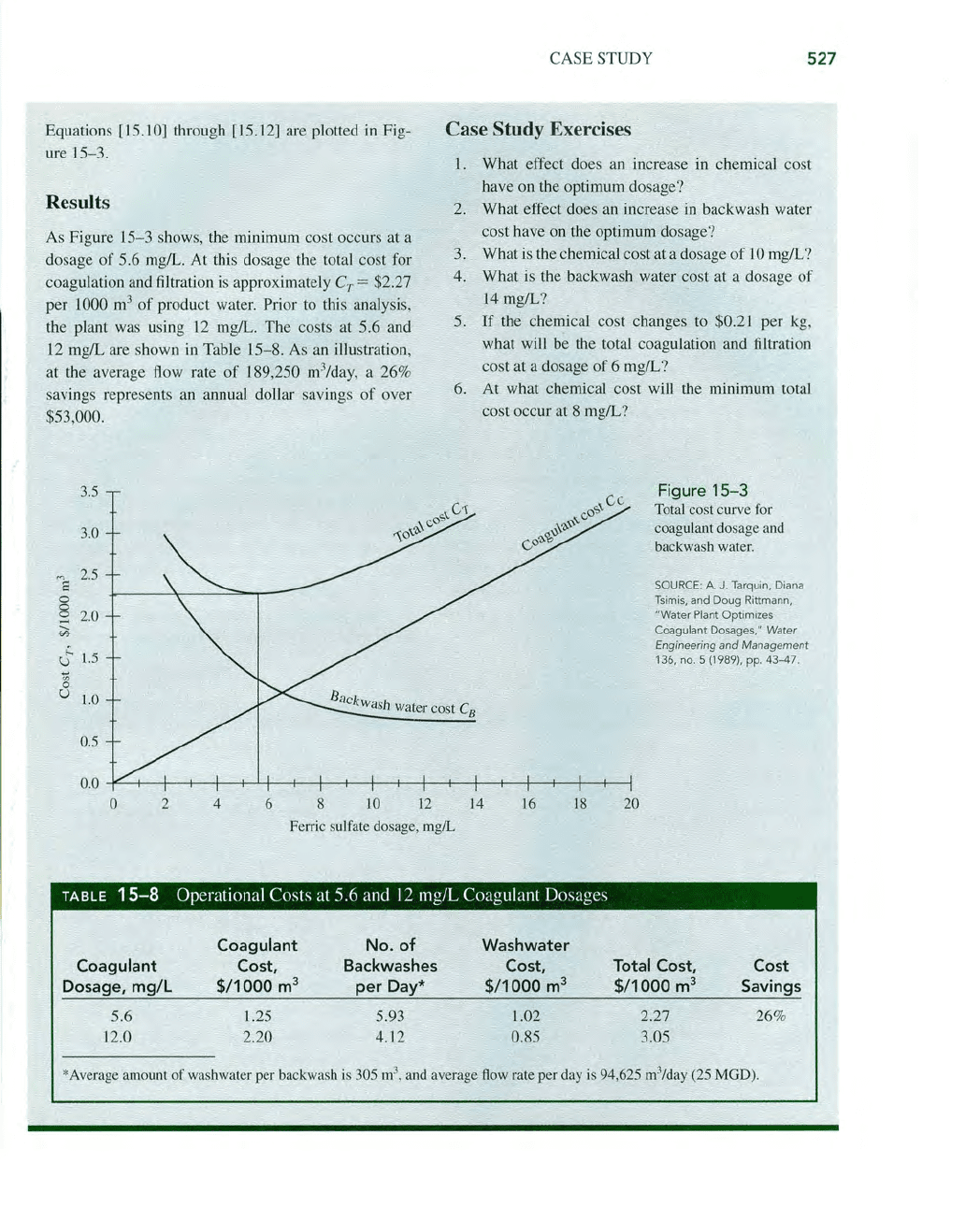
Equations [15.10] through [15.1
2]
are plotted
in
Fig-
ure
15
-
3.
Results
As
Figure
15
- 3 show
s,
the minimum cost occurs at a
dosage
of
5.6 mg/L. At this dosage the total cost for
coag
ul
ation and filtration is approximately C
T
= $2.27
per
1000 m
3
of product water. Prior to this analysis,
the plant was us
in
g 12 mg/L. The costs at 5.6 a
nd
12
mg/L are shown in Table
15
-
8.
As
an
illustra
ti
on,
at the average flow rate
of
189,250 m
3
/day, a 26%
savings represents
an
annual dollar savings
of
over
$53,000.
3.5
3.0
"'2
2.5
0
0
S
2.0
;;;.
.::,
1.5
U
u:
0
U
1.0
0.5
0.0
0
2
4
6 8
10
12
CASE STUDY
527
Case Study Exercises
1.
What effect does
an
increase in chemical cost
have on the optimum dosage?
2.
What effect does
an
increase in backwash water
cost have on the optimum dosage?
3.
What is the chemical cost at a dosage
of
10
mg/L?
4.
What is the backwash water cost at a dosage
of
14 mg/L?
5.
If
the chemical cost changes to $0.21 per kg,
what will be the total coagulation and filtration
cost at a dosage
of
6 mglL?
6. At what che
mi
cal cost will the minimum total
cost occur at 8 mg/L?
14
16
18 20
Figure
15-3
Total cost curve for
coag
ul
a
nt
dosage a
nd
backwash water.
SOURCE: A. J. Tarquin, Diana
Ts
imis, and D
oug
Ri
ttman
n,
"
Wa
te
r Plant
Op
timizes
Coagulant
Dosages," W
ate
r
Engineering
an
d Man
agemen
t
136, no. 5 (1989), pp. 4
3-47
.
Fe
rri
c sulfate dosage, mg/L
TABLE
15-8
Operational Costs at 5.6 and
12
mg/L Coagulant Dosages
Coagulant
No.
of
Washwater
Coagulant
Cost, Backwashes Cost,
Total Cost,
Cost
Dosage,
mg/L
$/1000
m
3
per
Day*
$/1000
m
3
$/1000
m
3
Savings
5.6 1.25 5.93 1.02 2.27
26%
12.0 2.20 4.12 0.85 3.05
* Average amount
of
washwater per backwash is 305 m
3
,
and average
fl
ow rate per day
is
94,625 m
3
/day (25 MGD).
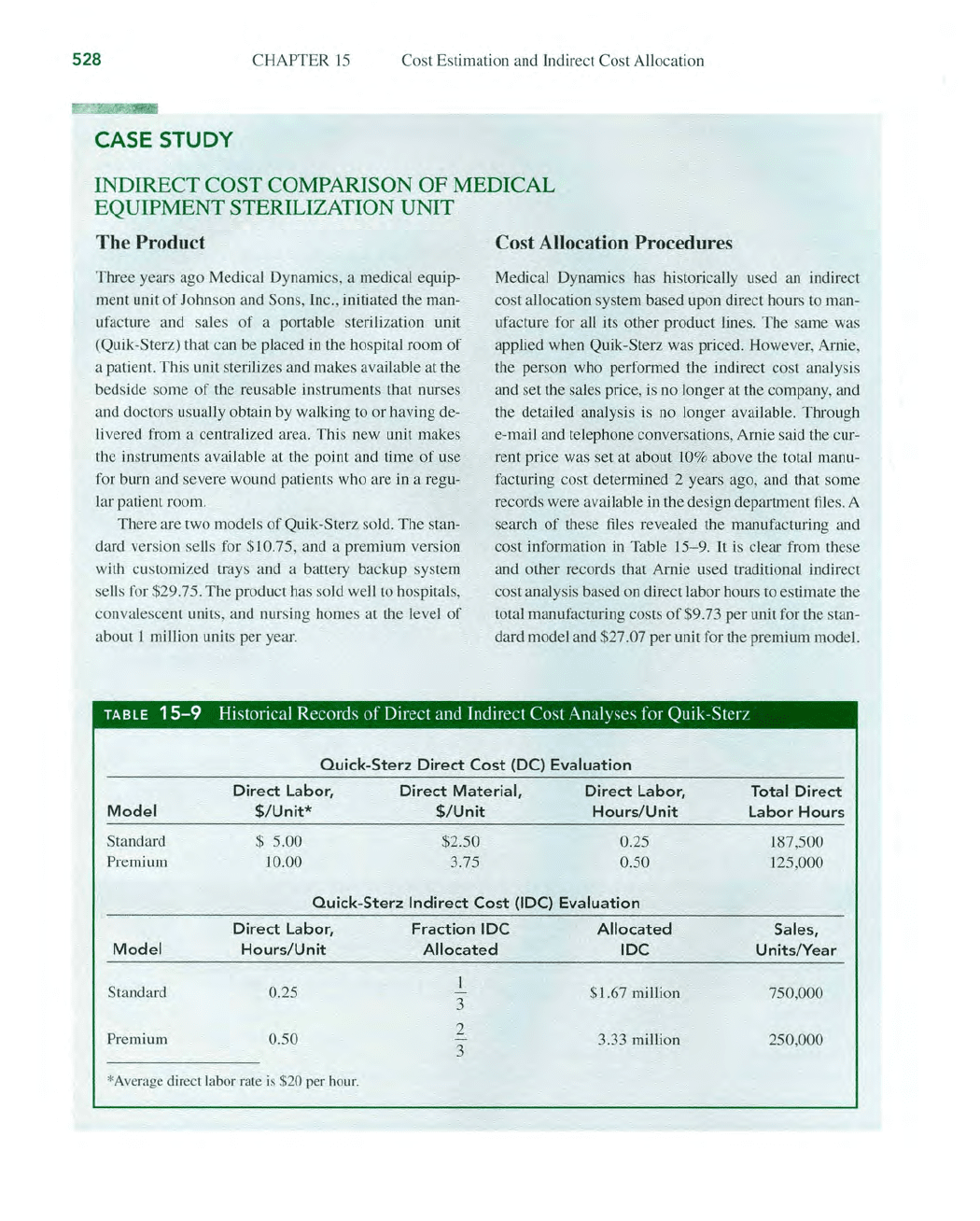
528
CHAPTER 15
Cost Est
im
ation and Indirect Cost Allocation
CASE
STUDY
INDIRECT
COST
COMPARISON
OF
MEDICAL
EQUIPMENT
STERILIZATION
UNIT
The Product
Three years ago Medical Dynamics, a medical equip-
ment unit
of
Johnson and Sons,
In
c., initiated the man-
ufacture and sales
of
a portable sterilization unit
(Quik-Sterz) that can be placed
in
the hospital room
of
a patient. This unit sterilizes a
nd
makes available at the
beds
id
e some
of
the
reu
sa
bl
e
in
strumen
ts
that nurses
and doctors usua
ll
y obtain by walking to
or
having de-
livered from a centralized area. This new unit makes
the
in
struments available at the po
in
t a
nd
ti
me
of
use
for burn and severe wound patients who are in a regu-
lar patient room.
There are two models
of
Quik-Sterz sold. The stan-
dard version sells for $10.75, and a premium version
with customized trays and a battery backup system
se
ll
s for $29.75. The product has sold we
ll
to hospitals,
convalescent units, and nursing homes
at
the level
of
about I million units per year.
Cost Allocation Procedures
Medical Dyna
mi
cs has historically used an indirect
cost allocation system based upon direct hours to man-
uf
acture for
al
l its other product lines.
The
sa
me
was
app
li
ed when Quik-Sterz was priced. However, Arnie,
the person who perfOlmed the indirect cost
ana
lysis
and set the sales price, is no longer at the company, and
th
e deta
il
ed analysis is no longer available. Through
e-mail and telephone conversations, Arnie said the cur-
rent price was set at about 10% above dle total manu-
facturing cost determiJled 2 years ago, and that some
records were available in the design department
fil
es. A
search
of
these files revealed the manufacturing and
cost information
in
Table
15-9
.
It
is
clear from these
and o
th
er records
th
at
Arnie used traditional indirect
cost analysis based
on
dil"ect
labor hours to estimate the
total manufacturing costs
of
$9.73 p
er
unit for the stan-
dard model and
$27.07 per unit for
th
e premium model.
TABLE
15-9
Historical Records
of
Direct and Indirect Cost Analyses for Quik-Sterz
Ouick-Sterz Direct Cost (DC) Evaluation
Direct Labor, Direct Material,
Direct Labor,
Model
$/Unit*
$/Unit
Hours/Unit
Standa
rd
$ 5.00 $2.50 0.25
Pr
emium 10.
00
3.75 0
.5
0
Ouick-Sterz Indirect Cost (IDC) Evaluation
Direct Labor, Fraction IDC Allocated
Model
Hours/Unit Allocated IDC
0.25
I
$1.67 million
-
3
Standa
rd
Premium
0.50
2
3.33 million
3
*Average direct labor rate is $20 per hou
r.
Total Direct
Labor Hours
187,
500
125,000
Sales,
Units/Year
750,000
250,000
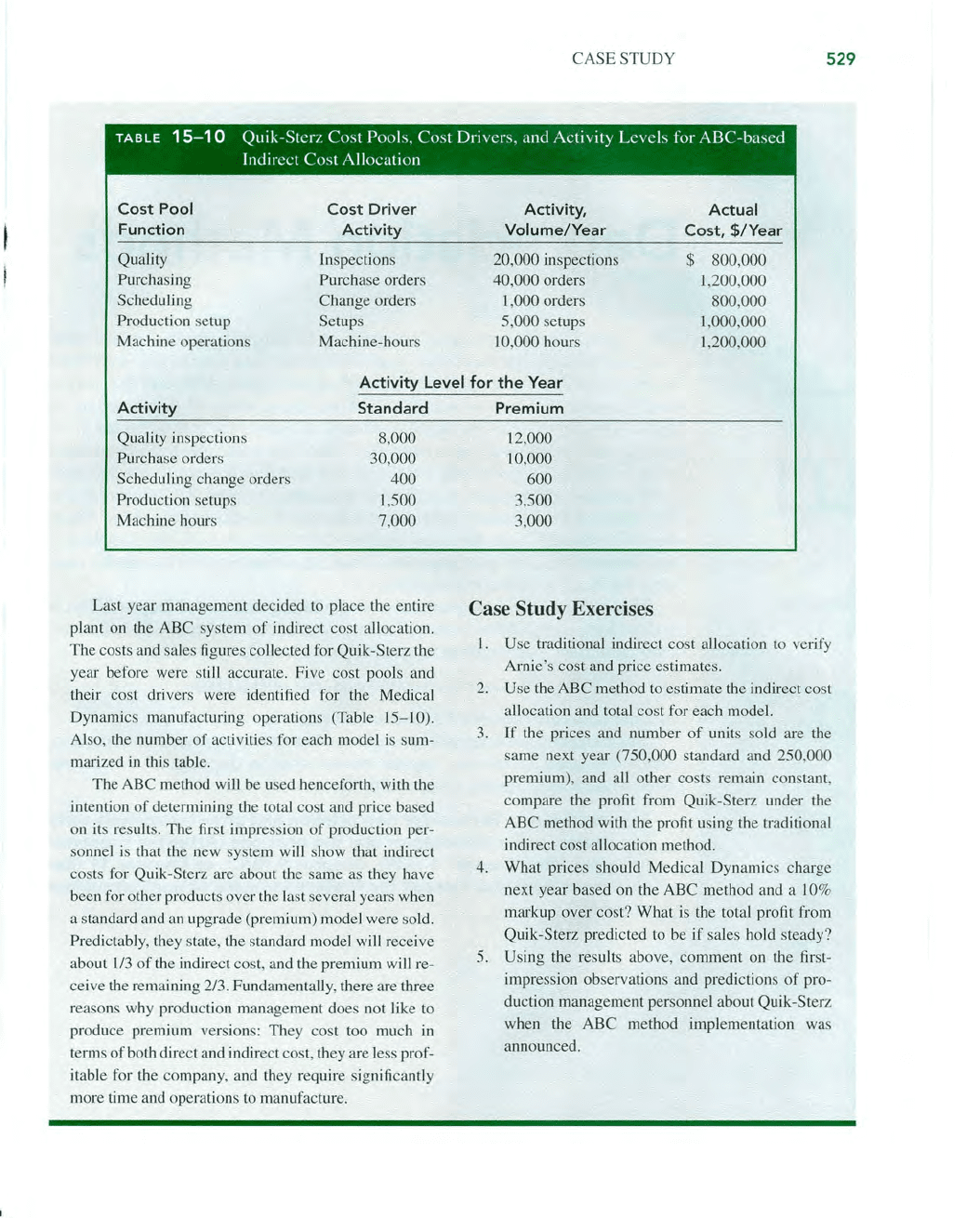
CASE
STUDY
529
TABLE
15-10
Quik-Sterz
Cost
Pools.
Cos
t Drivers. and Activity Levels for ABC-based
Indirect Cost A
ll
oca
ti
on
Cost Pool
Function
Quality
Purchasing
Sche
duLin
g
Produc
ti
on
se
tup
Machine opera
ti
ons
Co
st
Driver
Activity
Inspections
Purchase orders
Change orders
Setups
Ma
chjne-hours
Activity,
Volume/Year
20,000 inspections
40,000 orders
1,000 orders
5,000 setups
10
,000 hours
Actual
Cost,
$/Year
$ 800,000
1,200,000
800,000
1,000,000
1,200,000
Activity
Activity Level for the Year
Standard Premium
Qua
li
ty
inspections
Purchase orders
Scheduling change orders
Produ
ct
ion
se
tups
Machine hours
8,000
30,000
400
1,500
7,000
La
st year management decided to place the entire
pJ
ant on the ABC system
of
indlrect cost alloca
ti
on.
The costs and sales
fi
gures
co
ll
ected for Quik-Sterz the
year before were still accurate. Five cost pools a
nd
th
eir cost drivers were
id
entified for the
Med
ical
Dynamics ma
nu
factur
in
g operations (Table
15
- 10).
Also,
th
e number
of
ac
ti
v
iti
es for each model is sum-
marized
in
this ta
bl
e.
The ABC me
th
od will be
lI
sed hen
cef
orth, with
th
e
inte
nti
on
of
determining the total cost aud price based
on i
ts
result
s.
The
fi
rst impression
of
production per-
so
nn
el is
th
at
th
e new system
wi
ll show
th
at indirect
costs for Quik-Sterz are about
th
e
sa
me as they have
been for other products over the l
ast
several years when
a standard and an upgrade (prem
iu
m) model were sold.
Predictabl
y,
they state, the standa
rd
model w
ill
receive
about
11
3 of
th
e indirect cost, a
nd
the premium
wi
ll
re-
ceive
th
e rema
in
ing 2/3. Fundamen
ta
lly, there are thr
ee
reasons why produc
ti
on management does not
li
ke
to
produce premium version
s:
They cost too much
in
terms of bo
th
djrect and indirect cost, they are less prof-
it
able for the company, and
th
ey require sig
nifi
cantly
more time and operations to manufacture.
12
,000
10,000
600
3,500
3,000
Case Study
Ex
ercises
1.
Use traditional indirect cost allocation to verify
Arnie's cost a
nd
pr
ice estimate
s.
2.
U
se
the ABC me
th
od to estimate the indlrect cost
a
ll
ocation and total cost for each model.
3.
If
th
e prices a
nd
number
of
units sold are the
same next year
(7
50,000 standard and 250,000
premium), and a
ll
other costs rema
in
constant,
compare the pro
fi
t from Quik-Sterz under the
A
BC
method with
th
e profit us
in
g the traditional
in
dl
rect cost allocation method.
4. What prices should Medical Dyna
mi
cs charge
next year based on the ABC method and a
10
%
markup over cost?
What
is the total profit from
Quik-Sterz predicted to be if sales hold steady?
5.
Us
ing the results above, comment on the first-
impression observations and predictions of pro-
duc
ti
on management perso
nn
el about Quik-Sterz
when the ABC method implementa
ti
on was
announced.
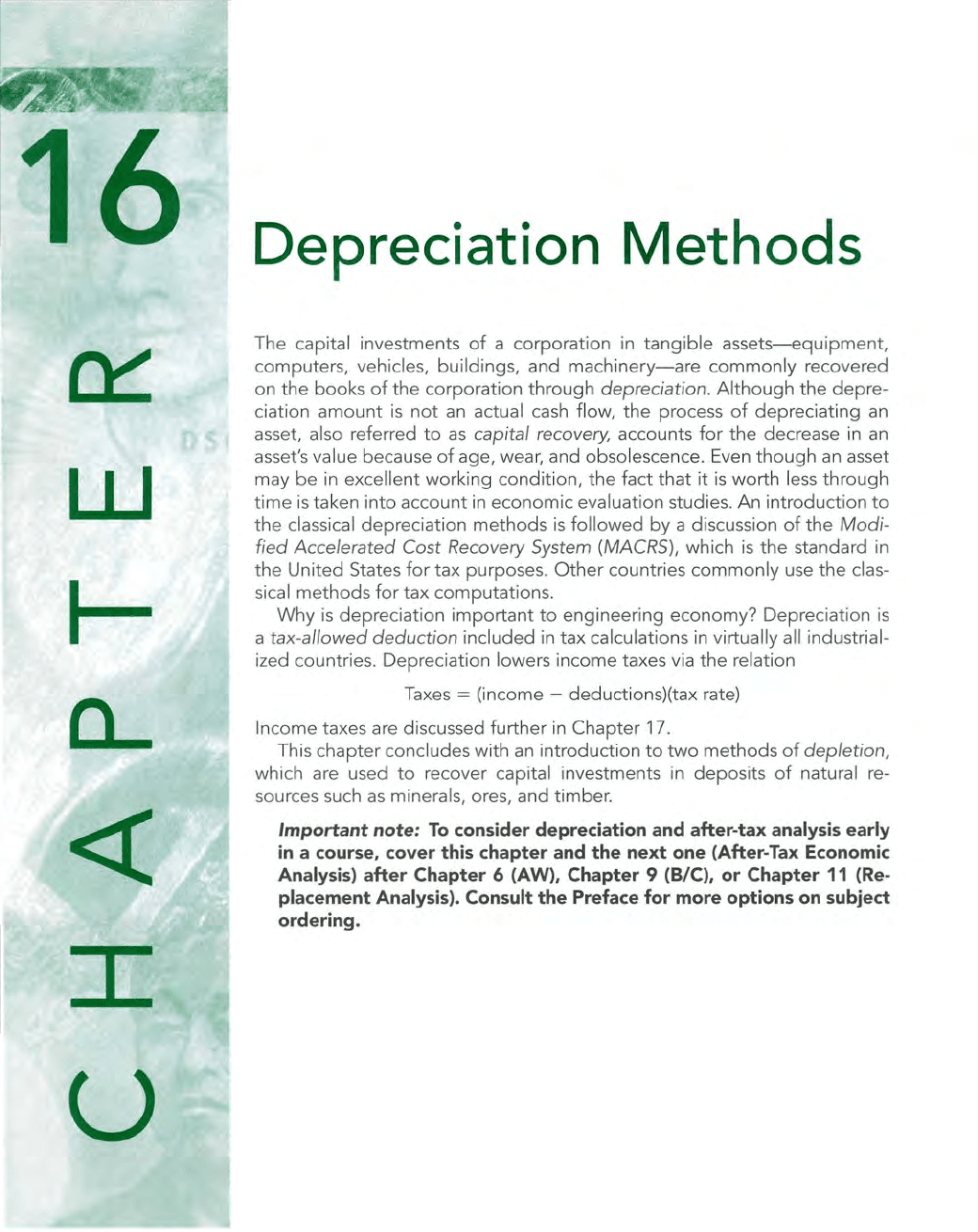
w
u
Depreciation Methods
The
capital
investments
of
a
corporation
in
tangible
assets-equipment,
computers,
vehicles,
buildings,
and
machinery-are
commonly
recovered
on
the
books
of
the
corporation
through
depreciation.
Although
the
depre-
ciation
amount
is
not
an actual cash flow,
the
process
of
depreciating
an
asset, also referred
to
as
capital recovery, accounts
for
the
decrease in
an
asset's value because
of
age, wear, and obsolescence. Even
though
an
asset
may
be
in
excellent
working
condition,
the
fact
that
it
is
worth
less
through
time
is
taken
into
account
in
economic
evaluation
studies.
An
introduction
to
the
classical
depreciation
methods
is
followed
by
a discussion
of
the
Modi-
fied
Accelerated
Cost
Recovery
System
(MACRS), which
is
the
standard in
the
United
States
for
tax
purposes
.
Other
countries
commonly
use
the
clas-
sical
methods
for
tax
computations.
Why
is
depreciation
important
to
engineering
economy?
Depreciation
is
a tax-allowed deduction
included
in
tax
calculations in virtually all industrial-
ized countries.
Depreciation
lowers
income
taxes via
the
relation
Taxes
= (income -
deductions)(tax
rate)
Income
taxes are discussed
further
in
Chapter
17.
This
chapter
concludes
with
an
introduction
to
two
methods
of
depletion,
which are used
to
recover
capital investments in
deposits
of
natural re-
sources such
as
minerals, ores,
and
timber.
Important
note:
To
consider depreciation and
after-tax
analysis early
in
a course, cover this
chapter
and
the
next
one (After-Tax Economic
Analysis)
after
Chapter
6 (AW),
Chapter
9 (B/C),
or
Chapter
11 (Re-
placement Analysis). Consult
the
Preface
for
more
options on subject
ordering.
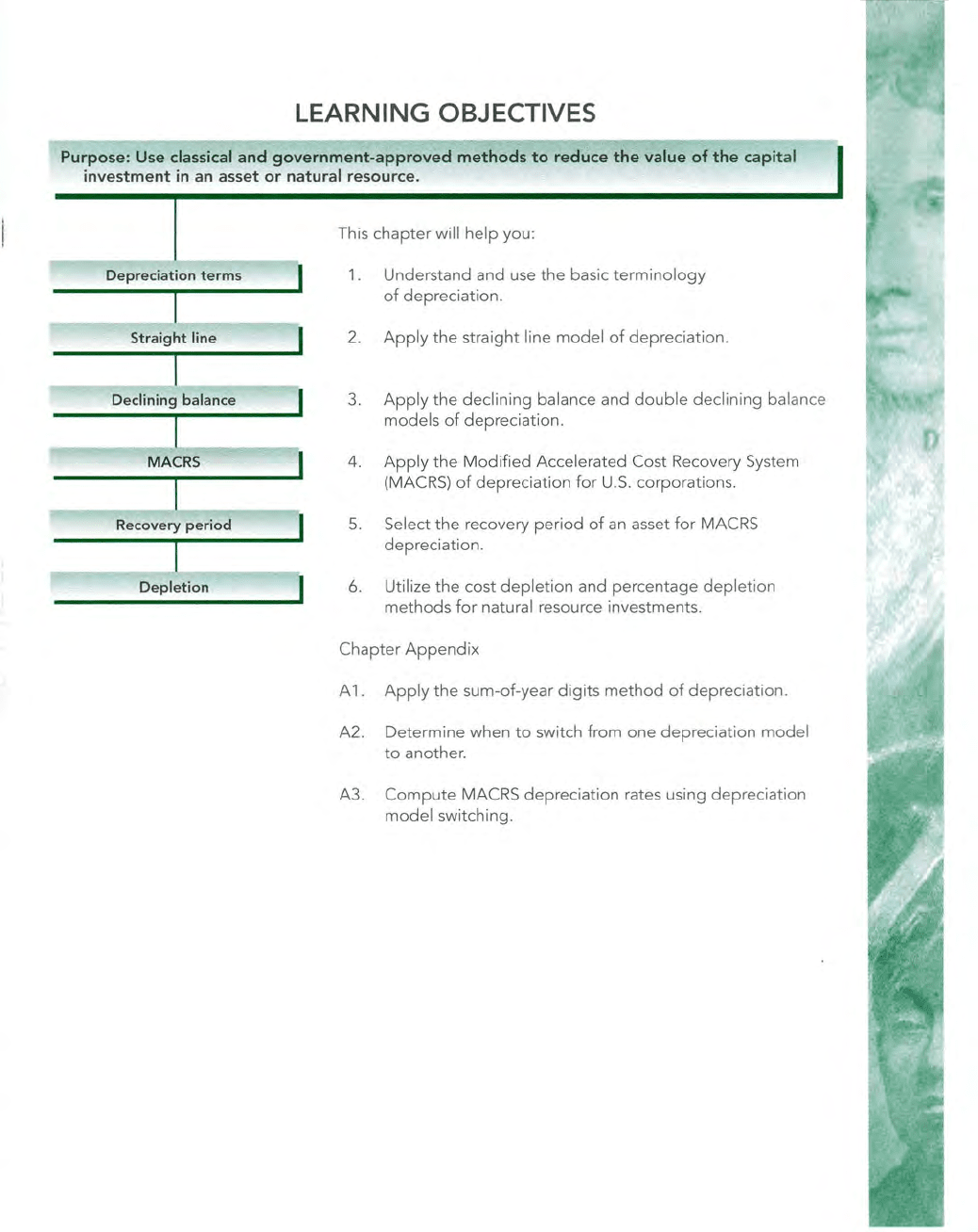
LEARNING OBJECTIVES
Purpose: Use classical and
government-approved
methods
to
reduce
the
value
of
the
capital
investment
in
an asset
or
natural resource.
Depreciation terms
Straight line
Declining balance
Recovery period
Depletion
This
chapter
will
help
you:
1. Understand and use
the
basic
terminology
of
deprec
iation.
2.
App
ly
the
strai
ght
li
ne
model
of
depreciation.
3.
Apply
the
decl
ining balance and
double
declining
balance
mode
ls
of
deprec
iation.
4.
App
ly
th
e Modified Accelerat
ed
Cost
Recovery System
(M
AC
R
S)
of
dep
reciation f
or
U
.S.
corporation
s.
5. Select
the
recovery
per
i
od
of
an asset
for
MACRS
depreciation.
6.
Utilize
the
cost
dep
l
etion
and
percentage
depletion
methods
for
natural resource investments.
Chapter
Appendix
A
1.
Apply
the
sum-of-year
digits
method
of
depreciation.
A2.
Determine
when
to
switch from
one
depreciation
model
to
another
.
A3.
Compute
MACRS
deprec
iation rates
us
ing
depreciation
model
switching.

532 CHAPTER
16
Depreciation Methods
16
.1 DEPRECIATION TERMINOLOGY
Primary terms used
in
depreciation are defined here. Most terms are applicable to
corporations as well as individuals who own depreciable assets.
Depreciation
is
the reduction
in
value
of
an asset. The method used to depre-
ciate an asset is a way to account for the decreasing value
of
the asset
to
the
owner
and
to represent the diminishing value (amount)
of
the capital funds
invested
in
it. The annual depreciation amount
D/
does not represent
an
actual cash
flow,
nor does it necessarily reflect the actual usage pattern
of
the asset during ownership.
Book
depreciation
and
tax
depreciation
are terms used to describe the purpose
for reducing asset value. Depreciation may be performed for two reasons:
I. Use
by
a corporation
or
business for internal financial accounting.
This
is
book depreciation.
2.
Use
in
tax calculations per government regulations. This
is
tax depre-
ciation.
The methods applied for these two purposes
mayor
may not utilize the same
formulas, as is discussed later. Book depreciation indicates the reduced
in-
vestment
in
an asset based upon the usage pattern and expected useful life
of
the asset. There are classical, internationally accepted depreciation meth-
ods used to determine book depreciation: straight line, declining balance,
and the infrequently used sum-of-year digits method. The amount
of
tax de-
pr
eciation is important in
an
after-tax engineering economy study because
of
the following:
In
the
United
States
and
many
industrialized
countries,
the
annual
tax
depreciation
is
tax
deductible;
that
is,
it
is
subtracted
from
in-
come
when
calculating
the
amount
of
taxes
due
each
year. However,
the
tax
depreciation
amount
must
be
calculated
using a
government-
approved
method.
Tax depreciation may be calculated and referred to differently
in
countries
outside the
United States. For example,
in
Canada the equivalent
is
CCA
(capital cost allowance), which
is
calculated based on the undepreciated
val
ue
of
all corporate properties that form a particular class
of
assets, whereas
in
the
United States, depreciation may be determined for each asset separately.
Where allowed, tax depreciation
is
usually based on
an
accelerated
method, whereby the depreciation for the first years
of
use is larger than that
for later years. In the
United States, this method
is
called MACRS, as covered
in
later sections. In effect, accelerated methods defer some
of
the income tax
burden to later
in
the asset's life; they do not reduce the total tax burden.
First
cost or
unadjusted
basis
is
the delivered and installed cost
of
the asset
including purchase price, delivery and installation fees, and other deprecia-
ble direct costs incurred to prepare the asset for use. The term unadjusted
basis
B,
or simply basis,
is
used when the asset
is
new, with the term ad-
justed basis used after some depreciation has been charged.
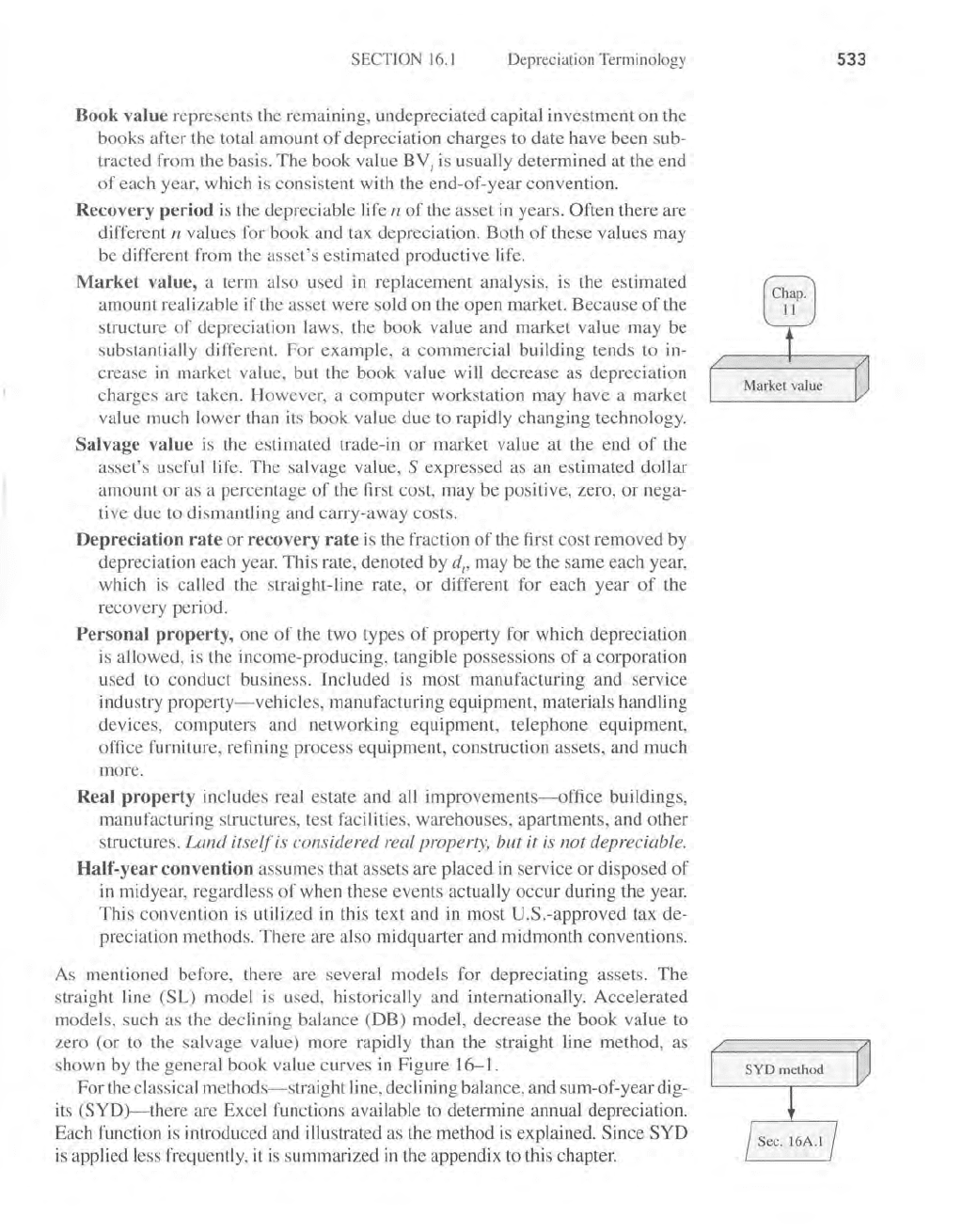
SECTION
16.
I Depreciation Terminology
Book
value
represents the remaining, undepreciated capital investment on the
books after the total amount
of
depreciation charges to date have been sub-
tracted from the basis. The book value BV
r
is
usually determined at the end
of
each year, which
is
consistent with the end-of-year convention.
Recovery
period
is
the depreciable life n
of
the asset
in
years. Often there are
different n values for book and tax depreciation. Both
of
these values may
be different from the asset's estimated productive life.
Market
value, a term also used in replacement analysis, is the estimated
amount real izable if the asset were sold on the open market. Because
of
the
structure
of
depreciation laws, the book value and market value may be
substantially different. For example, a commercial building tends to in-
crease
in
market value, but the book value will decrease as depreciation
charges are taken. However, a computer workstation may have a market
value much lower than its book value due to rapidly changing technology.
Salvage
value
is
the estimated trade-in
or
market value at the end
of
the
asset's useful life. The salvage value, S expressed as an estimated dollar
amount
or
as a percentage
of
the first cost, may be positive, zero,
or
nega-
tive due to dismantling and carry-away costs.
Depreciation
rate
or
recovery
rate
is
the fraction
of
the first cost removed by
depreciation each year. This rate, denoted by
dl' may be the
same
each year,
which
is
called the straight-line rate,
or
different for each year
of
the
recovery period.
Personal
property,
one
of
the two types
of
property for which depreciation
is
allowed,
is
the income-producing, tangible possessions
of
a corporation
used to conduct business. Included is most manufacturing and service
industry
property-vehicles,
manufacturing equipment, materials handling
devices, computers and networking equipment, telephone equipment,
office furniture, refining process equipment, construction assets, and much
more.
Real
property
includes real estate and all
improvements-office
buildings,
manufacturing structures, test facilities, warehouses, apartments, and other
structures. Land
itself
is considered real property,
but
it is
not
depreciable.
Half-year
convention
assumes that assets are placed in service
or
disposed
of
in
midyear, regardless
of
when these events actually occur during the year.
This convention
is
utilized
in
this text and in most U.S.-approved tax de-
preciation methods. There are also midquarter and midmonth conventions.
As
mentioned before, there are several models for depreciating assets. The
straight line (SL) model
is
used, historically and internationally. Accelerated
models, such as the declining balance (DB) model, decrease the book value to
zero (or to the salvage value) more rapidly than the straight line method, as
shown by the general book value curves in Figure 16-1.
For the classical
methods-straight
line, declining balance, and sum-oF-year dig-
its
(SYD)-there
are Excel functions available to determine annual depreciation.
Each function
is
introduced and illustrated as the method is explained. Since SYD
is applied less frequently,
it
is
summarized
in
the appendix to this chapter.
533
I Sec. J6A.1 I
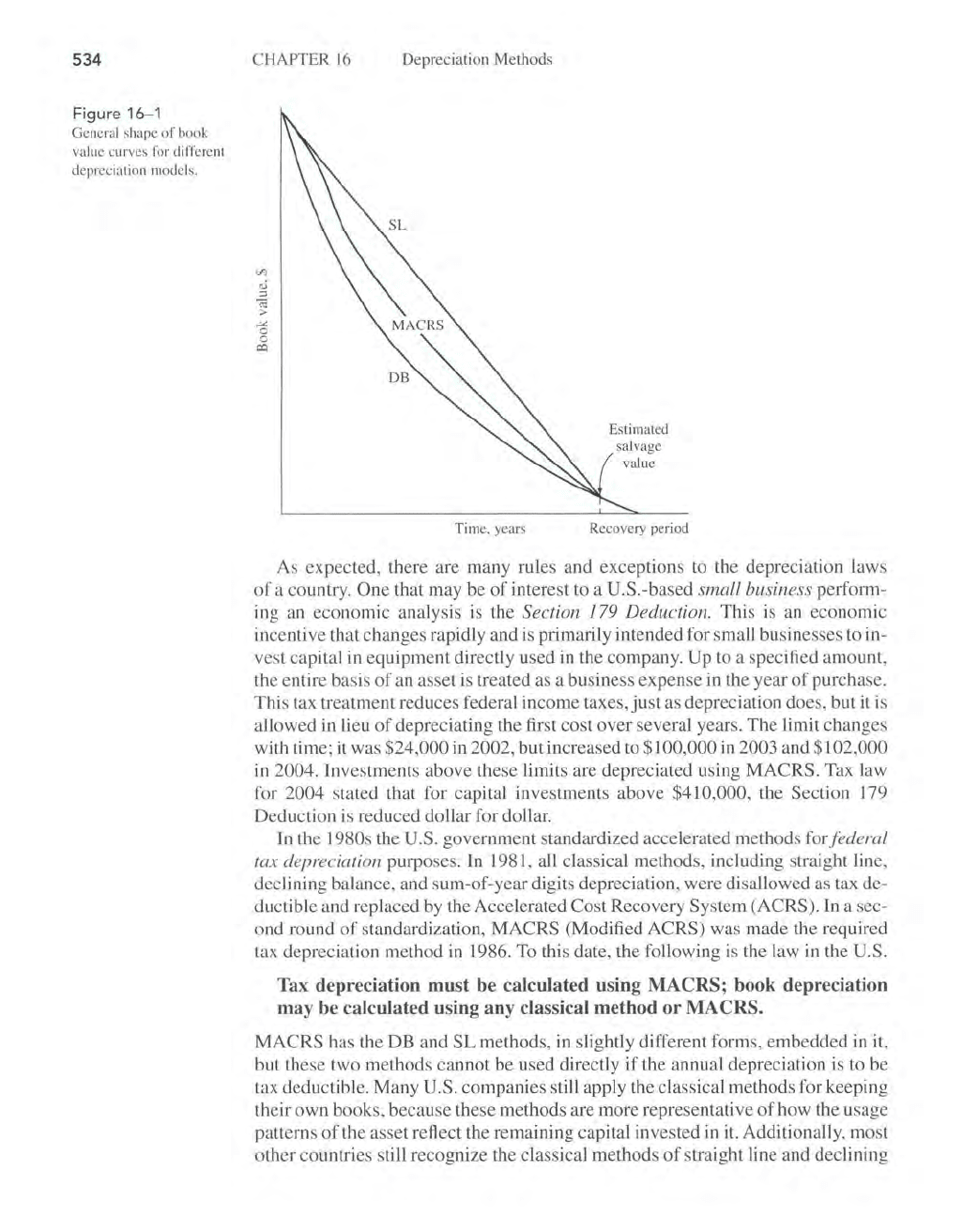
534
Figure
16-1
General shape or book
value curv
es
for difTere
nt
depr
ec
iation model
s.
CHAP
TE
R 16
Depreciation Methods
-'"
o
o
co
Tim
e, years
Estimat
ed
s
al
vage
va
lue
R
ec
o
ve
ry period
As expected, there are many rules and exceptions to the depreciation laws
of
a country. One that may be
of
interest to a U.S.-based small busin.ess perform-
in
g an economic analysis
is
the Section 179 Deduction. This is an economic
incentive
th
at changes rapidly and
is
primarily intended for small businesses to in-
vest capital
in
equipment directly used in the company. Up to a specified amount,
th
e entire basis
of
an asset is treated as a business expense
in
th
e year
of
purchase.
This tax treatment reduces federal income taxes,
ju
st as depreciation does, but it is
allowed
in
lieu
of
depreciating the first cost over several years.
The
limit changes
with time; it was
$24,000 in 2002, but increased to $100,000 in 2003 and $102,000
in
2004. Investments above these limits are depreciated using MACRS. Tax law
for
2004 stated that for capital investments above $410,000, the Section 179
Deduction is reduced dollar for dollar.
In
the 1980s the U.S. government standardized accelerated methods
fo
rJ
ederal
tax de
pr
eciation purposes.
In
1981
, all classical methods, including straight line,
declining balance, and sum-of-year digits depreciation, were disallowed as tax de-
ductible and replaced
by
the Accelerated Cost Recovery System (ACRS). In a sec-
ond round
of
standardization, MACRS (Modified ACRS) was made the required
tax depreciation method in ] 986. To this date, the following is the law
in
the U.S.
Tax depreciation
must
be calculated using MACRS; book depreciation
may be calculated using
any
classical method
or
MACRS.
MACRS has the DB and
SL
methods,
in
slightly different forms, embedded in it,
but these two methods cannot be used directly
if
the annual depreciation
is
to be
tax deductible. Many
U.S. companies still apply the classical methods for keeping
th
eir own books, because these methods are more representative
of
how the usage
patte
rn
s of the asset re
fl
ect the remaining capital invested in
it.
Additionally, most
o
th
er countries still recognize the classical methods
of
straight line and declining
